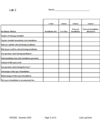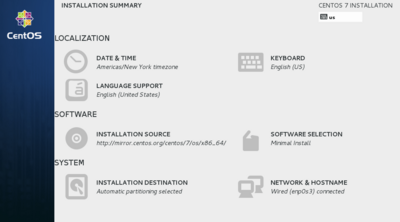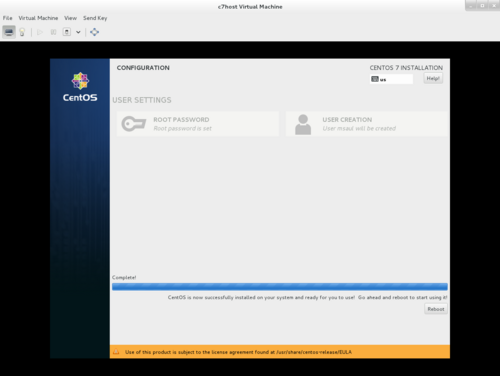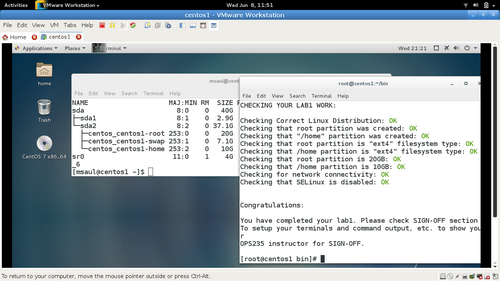OPS235 Lab 1 - CentOS7
Contents
LAB PREPARATION
Purpose / Objectives of Lab 1
You need to install a Linux OS to be a host or "platform" to install and use other Linux VMs (Virtual Machines) during this course.
The Linux OS you will be installing in this lab will be a Host Machine (hostname: c7host) that will allow you to run Virtualization Software to create 3 separate virtual machines (to be performed in lab2). It is important to install this host machine correctly since other labs will depend on the stability of this host machine.
Main objectives:
- Correctly install the CentOS 7 FULL INSTALL DVD (not LIVE DVD) on your removable hard disk.
- Record installation characteristics of CentOS 7 FULL INSTALL in a chart (contained in lab2 logbook chart) to compare with other installation methods performed in lab2.
- Verify correct settings prior to proceeding with host installation stages.
- Obtain Linux server information after installation to create a software asset report for later access.
- Disable Linux Kernel security enhancements to allow easier internal networking connections (to be reactivated in a later lab).
- Observe that Bash Shell Scripts can automate routine tasks.
Minimum Required Materials
My Toolkit (CLI Reference)
| Package Management | System Information | Networking | Miscellaneous |
INVESTIGATION 1: CREATE HOST MACHINE (c7host)
For the next 3 investigations, you will learn how to install your Centos Full DVD onto your removable hard disk. You will customize your install to setup several separate partitions:- / (The "root" partition)
- /home (Store regular user accounts)
- /var/lib/libvirt/images (store virtual machine images to be created in lab2)
- swap partition (Virtual Memory)
Make certain to record your observations of this install in the comparison chart for c7host in your lab2 logbook.
Part 1: Start Installation
- Host Machine Details:
- Name: c7host
- Boot media / Installation: CentOS7 Full Install DVD
- Memory: 16GB
- Disk space: 250GB (or higher)
- CPUs: 1
- Refer to this listing of installation screenshots if you need a reference:
[ installation screenshots ] - Insert your removable SATA hard disk into the drive tray.
- Set your computer's drive selector switch to external (a.k.a position #4).
- Power up the computer and insert the CentOS 7 Installation DVD into the DVD drive, then power-off computer.
- Determine if your computer is the newer or older model. Newer computer models are labelled HP Z230.
NOTE: If you are using the newer model, allow the computer to boot up (without pressing F10 key) to boot from DVD. For older models, press F10, press ENTER for password, and select the DVD drive. Refer to the comparison chart in lab2 lab logbook, and fill in various installation information for c7host while you perform the installation (such as time it took to perform a full install, installation options, etc).
WARNING: Only use the same type of computer (only the newer computer or only the older computer) when working in the Seneca labs for the duration of this course!
- Select the option Test this Media & Install Centos7. Your DVD will be checked for defects.
- If the check is successful, you will be prompted for a language. In the first screen, select language English with subselection English-Canada and then click the Continue button on the bottom right-hand screen.
- The Install Summary should now appear. This screen allows the installer to customize their Centos7 system prior to installation.
- Configure the following installation settings from the Install Summary Screen:
DATE & TIME:- Click on the Map to select Toronto area (you may also select from the drop-down menu section)
- Click the DONE button at the top-left corner to finish and return to the Installation Summary screen.
NETWORK & HOSTNAME:- Select the default Ethernet connection and click the button on the top right-hand side to change the setting from OFF to ON.
- At the bottom left-hand corner type the hostname: c7host (all lowercase letters)
- Review your settings, then click the DONE button at the top-left corner to finish and return to the Installation Summary screen.
SOFTWARE SELECTION:- Select the software packages labelled: Gnome Desktop
- Click the DONE button at the top-left corner to finish and return to the Installation Summary screen.
- Although the Centos installtion program can provide suggestions on how to partition your hard disk, you will be customizing partitions for your hard disk. This custom partitioning is important since it will have consequences on future labs that you perform (especially for lab2).
Proceed to Part 2 to customize your partitions.
Part 2: Custom Partitioning
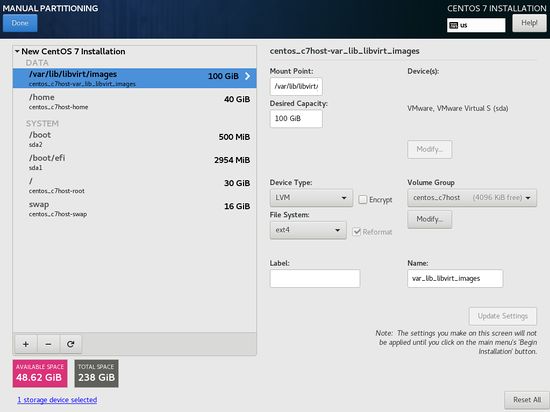 Carefully verify partition mount-names and sizes prior to proceeding with install. Check installation screenshots link for verification. |
- From the installation summary screen, click Installation Destination.
- In the installation destination screen, select the destination option: I will configure partitioning and then click Done.
- The manual partitioning screen should appear.
- If you have used your hard disk for previous Linux (Centos) distributions, you should remove them. Click on the distribution, and for each partition, select the partition and click the remove button (minus sign) and confirm deletion.
- Change the option New mount points will use the following partition scheme from LVM to Standard Partition (you will not be using LVM for your c7host machine).
- Before you proceed with creating partitions, let's see the partitions that we need to create for our host computer:
- Primary Partitions (ext4):
- 30GB for / (i.e. "root")
- 40GB for /home
- 100GB for /var/lib/libvirt/images
- Swap Partition:
- 16GB (Note: "swap" must be selected from the drop down menu)
NOTE: Remember that the sizes are recorded in MB (eg. 30 GB = 30000 MB) and you should multiply GB by a factor of 1024 to get the correct size.
(eg. 30 GB x 1024 = 30720 MB) - Primary Partitions (ext4):
- We will now create the root (/) partition. Click on the add button (plus) sign.
- In the Add a New Mount Point screen, select / as the mount-point (either by typing or selecting from drop-down menu), and enter 30720 in for partition size and click Add Mount Point button.
- Repeat the same steps above for the /home partition and /var/lib/libvirt/images partition. You need to type the /var/lib/libvirt/images partition since it does not appear in the drop-down menu.
- Select each of the created partitions, and make certain that the file-system type is changed from xfs to ext4.
- Finally, add a swap partition (Mount Point: swap) for 16 GB.
- Check that your partition settings are correct (you can ask your instructor or lab monitor to confirm), and then click Done to proceed.
- A Summary of Changes screen will appear to show the partitioning operations that will be created. Click the Accept Changes and click Begin Installation in the Installation Summary screen to proceed with the installation.
- Start timing your host machine installation.
Part 3: Completing the Installation
- During the installation process, you will required to create a root password (for administration access) and create a regular user account. Click on Root Password and enter your root password. Think of an appropriate password and record that password somewhere in case you forget! An indicator will appear to show you how secure your password is. Retype your root password and click Done (you may have to click Done twice if your password is not considered to be a strong password).
- You need to create a regular user account. This account will be used to graphical log into your host machine. It is never recommended to graphically log into a graphical Linux/Unix system as root. It is better to log into a regular user account, then run a command to login as root (you will learn how to do this later in this lab).
- Click User Creation and enter your full name, username, and an appropriate password (and confirm password). Click Done to finish (click twice if password is not considered to be a strong password).
- Remember to record this host installation information in the installation comparison chart in the lab2 logbook.
- When installation is complete, you will notice a message at the bottom of the screen stating: CentOS is now successfully installed and ready for you to use!
- Click the Reboot button. Your DVD will briefly open in the DVD drive bay. Make certain to remove this installation DVD so that Centos will boot from your hard drive.
- After the system reboots, a boot menu should briefly appear, then prompt the user to accept the License Information (what is the purpose of accepting the license?).
- Click on License Information and click that you agree to the license agreement, click Done and then click Finish Configuration.
- Click Forward to enable Kdump (what is the purpose of this application?).
- The system should then graphically prompt the user to login with their regular user account. Click on your regular user account name and enter your regular user password.
- The last phase of the installation process should now run:
- Confirm English as the default input source and click Next.
- Skip the creation of online accounts by clicking Next.
- Start using your installed Linux system by clicking Start Using CentOS Linux.
- Stop timing your installation and note the amount of time that your installation took to perform. Also take the time to fill in the c7host section of the installation comparison chart in your lab2 logbook.
- Open a web-browser and check to see if you can connect to the Internet.
- Your system automatically enables a screen-saver application which is a useful security tool to prevent unauthorized viewing of information on a terminal after a certain amount of inactivity. If you find this feature annoying and want to turn it off or adjust the idle time perform the following steps:
- Click on your username at the top right-hand screen
- Select Settings from the drop-down menu
- Click the Power icon located in the Settings Dialog Box
- Change the amount of time in the Power Saving section to Never or a longer period of time
- Close the Settings Dialog box.
- Proceed to Investigation 2 to obtain basic information from your newly installed Centos Host machine.
Answer Investigation 1 observations (all parts and questions) in your lab log book.
INVESTIGATION 2: OBTAINING HOST MACHINE SYSTEM INFORMATION
Part 1: Obtaining Package Management / Package Information
Navigate through your Graphical CentOS system, locate and run a terminal program (in order to issue Linux commands). Issue and record the commands used and the output generated in each of the following steps:
- With older (ancient) versions of Linux, a user once may have been allowed to login to their graphical Linux system using root as their user-name and their root password. This has been determined to be a security risk and that option has been removed with many or all Linux operating systems.
- Therefore, from this point onwards, you will be logging into your regular user account instead and issuing a command to login as the root user.
- Refer to the Information box regarding how to access the admin account from the command line.
- Issue the command
suIssue the pwd and whoami commands to confirm your directory pathname. When finished logout of this account. - Issue the command
su -Issue the pwd and whoami commands to confirm your directory pathname. What do you notice are the main differences between using su versus using su - ? - An installation log file called
/var/log/anaconda/anaconda.packaging.loghas been created to record the installation of your c7host machine. This file is an ASCII file which can be viewed with themorecommand. - You can make use of this file to determine how many packages have been installed: complete the following command to count the number of packages that are labelled "Installing" in the installation log file:
-
grep -i installing /var/log/anaconda/anaconda.packaging.log | wc -l
-
- Issue that command displayed above. Does it work? If not, what account do you think you should be in? When you get the command working record this important information regarding commands and the admin account in your lab logbook.
- Using the
rpmcommand: you can also use the following commands to list all the installed packages, and the total number of packages installed:
rpm -q -arpm -q -a | wc -lrpm -qa | wc -l
- The
-qoption means query, and the-aoption means all (in other words, query all installed software packages). Did you get the same number of packages from the above two methods? - Some of the files on your system were installed with the software packages, and some were created by system activity (for example, by creating your Learn account and by logging in). If you know the package name (from the
install.log), you can list all the files that were installed from the package by using the following command:
rpm -q -l gedit
- Issue the following command to obtain the total number of files installed for gedit:
rpm -ql gedit | wc -l
- Using what you learned in steps 3, 4, and 7, get a count of the total number of files installed by all of the software packages on your system.
- How can you explain why this number is a lot larger than the total number of packages installed? Record your answer in your lab logbook.
Part2: Obtaining System Information
- To find out the name that you have assigned to your Linux system, enter the command:
hostname - To find out the kernel version of your GNU/Linux workstation and the date it was created, enter the command:
uname -rv - To find out all the system processes running on your GNU/Linux workstation, enter the command:
ps -ef - We will now collect networking information for your installed system.
- To check the network configuration settings obtained from the DHCP server, run the following commands, describing the output in your log book:
-
ifconfig -
route -n nslookup(at the nslookup prompt, enter the word server and record the output. Type exit to leave nslookup).
-
- Find the following information in the output of the above commands:
-
MAC addressof the ethernet network interface Subnet mask-
The IP address(assigned to you by the DHCP server) -
The default gateway -
The DNS nameserver
-
- Run the commands
hostname,uname -rv,ps -ef,ifconfig, androute -nredirecting the output to add to a file in root's home directory calledsystem.txt. - Copy the installation log file
/var/log/anaconda/anaconda.packaging.logand the file system.txt to a USB memory key, or scp to your matrix account as a backup.
Answer the Investigation 2 observations / questions in your lab log book.
INVESTIGATION 3: LOOKING AHEAD
Part 1: Disable SELinux and Perform Software Updates
- Disabling SELinux is quite simple, just edit the file /etc/selinux/config and set SELINUX to disabled.
- Add additional text regarding disabling SELinux.
- The CentOS software is updated frequently to add features, fix bugs, and upgrade security. Perform a system update to get the latest versions of the packages installed: Start the Firefox web browser, turn off popup window blocking (select Edit, Preferences, then select the Content tab and uncheck the box to Block Popups), then return to your web-browser, load a page, and when prompted, login to SeneNET.
- Make certain that you have at least 30 minutes available in your lab-time prior to performing a system update. Never abort a system update since it may damage your system files and render your host mahcine inoperable!
- Open a terminal and type
suto start a shell as root. Enter the commandyum updateThis will download and install all of the packages that have been updated since the installation DVD image was created. If you complete this command at Seneca it should run quite fast as Seneca College hosts a CentOS Repository mirror (a copy of all of the current CentOS packages, on a local web server).
Part 2: Automating Routine Tasks (Shell Scripting)
You may have learned about creating and running Bash Shell Scripts in your ULI101 course. Shell scripts help Linux users and system administrators to automate repetitive tasks to become more efficient and to help them save time. You will be reviewing and building a basic Bash Shell script to generate information reports for your newly-installed Linux host machine. Take time to view Shell Scripting Tips which are located on the right-hand side.
If you require additional practice in creating shell scripts and using the vi text editor, run the commands in your Matrix account:- /home/murray.saul/vi-tutorial
- /home/murray.saul/scripting-1
Perform the following steps in your c7host machine:
- Make certain to log out of your root account and remain as a regular user.
- Open a Shell terminal and use a text editor (such as
viornano) to create a Bash Shell script called:myreport.bashin your current directory. - Copy and paste the text below into your vi editing session for your file report.bash
(how do you copy and paste efficiently in Linux?)
#!/bin/bash
# Author: *** INSERT YOUR NAME ***
# Date: *** CURRENT DATE ***
#
# Purpose: Creates system info report
#
# USAGE: ./myreport.bash
if [ $USER != "root" ] # only runs if logged in as root
then
echo "You must be logged in as root." >&2
exit 1
fi
- Save your editing session, assign the myreport.bash file read and execute permissions (at least for the owner) and run by typing:
./myreport.bash - Did it run? If not what do you think you need to do in order to run the Bash Shell Script?
- Issue the command
su -and run the script from the regular user's home directory (not root's home directory):~regularuserid/myreport.bash - Did it work?
- Reopen your text-editing session for ~regularuserid/myreport.bash and add the following lines of code to the bottom of the shell script file:
# Create report title
echo "SYSTEM REPORT" > /root/report.txt
echo "Date: $(date +'%A %B %d, %Y (%H:%M:%p)')" >> /root/report.txt
echo >> /root/report.txt
- Save and run the bash shell script. View the contents of the file called report.txt that was generated (I hope you are using the up arrow key to issue previously issued commands in order to save time!). Notice how the redirection symbol > is used at the beginning of the report, and then the other redirection symbol >> is used to help "grow" the report with the other content.
- The only remaining content of the report would be the system information. We can use a shell scripting trick called "command substitution" $( .. ) in order place results from an command to be used by another command (like echo). Re-edit the shell script and add the following code at the bottom of the shell script file:
echo >> /root/report.txt
echo "Hostname: $(hostname)" >> /root/report.txt
echo >> /root/report.txt
echo "Kernel Version: $(uname -rv)" >> /root/report.txt
echo >> /root/report.txt
- Save, run the script, and view the report.txt contents (are you using tip that was given to save time?).
- Edit the shell script and include output from the
ps auxandifconfigcommands (with appropriate titles). Remember to redirect that output to add to the bottom of the file! - Save, run and confirm that the shell script is working correctly.
- What would be the use of keeping this shell script as a Linux system administrator?
- Here are some more "complex" Bash Shell scripts, that perform the same task. Although you are not require to understand some of these other tricks, it is recommended that you view the contents of the scripts and save them for future consideration or exmaples.
- The
wgetcommand can be used to quickly download files from the Internet. Issue the following command:wget https://scs.senecac.on.ca/~murray.saul/text-report.bash - Verify that the file text-report.bash was downloaded to your current directory.
- Assign read and execute permissions for this file by issuing the command:
chmod u+rx text-report.bash - Run this Bash Shell script by issuing the command:
./text-report.bash - Check to see if it created a report in your current directory. What is the purpose of the report?
- Use the vi text editor to view the contents of the file text-report.bash. Can you understand how this script works?
- Use the
wgetcommand to download, study, and run the following shell scripts on-line:https://scs.senecac.on.ca/~murray.saul/report.bash
https://scs.senecac.on.ca/~murray.saul/report3.bash - Try to understand what these Bash Shell scripts do.
- You have completed lab1. Proceed to Completing The Lab, and follow the instructions for "lab sign-off".
Answer the Investigation 3 observations / questions in your lab log book.
LAB 1 SIGN-OFF (SHOW INSTRUCTOR)
Arrange evidence (command output) for each of these items on your screen, then ask your instructor to review them and sign off on the lab's completion:
- ✓ Output of lsblk command showing correct partition names and sizes
- ✓ Contents of /etc/fstab file confirming partitions file types are ext4
- ✓ Correct IP address and MAC address
- ✓ Default route (gateway)
- ✓ DNS name server IP Address
- ✓ Contents of your report.bash shell script
- ✓ lab1 notes and first column of Comparison Chart in lab2.
ADDITIONAL PRACTICE
- How many packages were installed?
- How many files (correct to the nearest hundred) were installed?
- How many users were created automatically on your system (regular, admin)?
- List 3 ways that you can access your root account
- What is the difference between the commands su and su - ?
- What is the home directory for the user "root"?
- How do you determine the host name of your GNU/Linux workstation?
- What command can display the NIC's MAC address?
- What command is used to get a list of running processes on your newly-installed system?
- What is the command to copy files to your USB key?
- How can Shell Scripts be used to help automate a task performed in lab1?





